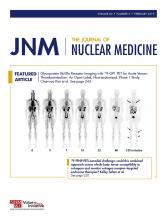Precision medicine is currently entering the surgical theater, with prostate-specific membrane antigen (PSMA)–radioguided surgery representing an excellent example combining the expertise of radiopharmacists, nuclear medicine imaging specialists, and urooncologic surgeons.
In recent years, novel techniques and tracer concepts in nuclear medicine have had a tremendous impact on prostate cancer imaging (1). In particular, PET imaging using agents targeting PSMA for the detection of prostate cancer lesions has clearly emerged as the preferred imaging standard in patients with rising levels of prostate-specific antigen after primary curative treatment (2,3). Especially in early biochemically recurrent prostate cancer, both patients and treating physicians face the difficult decision of whether secondary local therapy promising a potential cure is feasible or if systemic treatment needs be initiated. Here, PSMA-ligand PET enables detection of prostate cancer lesions even at low prostate-specific antigen levels below 1 ng/mL in 52%–64% of patients (4,5). With the information obtained by PSMA-ligand PET at hand, the treatment plan changed in 62% of patients in comparison to conventional imaging in a recent prospective Australian study on 260 men (6). Moreover, in a recent metaanalysis by Han et al. comprising 15 studies with 1,163 patients (primarily patients with biochemical recurrence), the treatment management was also modified in 54% of cases by the results of PSMA-ligand PET, with a clear shift toward targeted therapy options (7). However, if salvage surgery is considered, the successful detection and removal of cancerous lesions with a minimum of side effects are crucial. Because these mostly small and often atypically located metastatic lymph nodes are difficult to identify within a surgically pretreated or preirradiated region, surgical guidance is highly appreciated.
In the past, surgical guidance by radioguided approaches have been successfully implemented in the treatment of prostate cancer (8). Wawroschek et al. were the first to introduce the concept of sentinel lymph node dissection using 99mTc-nanocolloid (9). After local injection within the prostate, 99mTc-nanocolloid follows the lymphatic drainage, and intraoperative γ-probe tracing helps to identify radioactive lymph nodes. These first draining (sentinel) lymph nodes represent the first sites that may harbor metastatic prostate cancer cells. The surgical guidance aspects of this procedure were extended with intraoperative fluorescence imaging after the development of so-called hybrid tracers that contain not only a radiolabel but also a fluorescent label (e.g., indocyanine green–99mTc-nanocolloid) (10). However, lymphatic mapping, although able to identify micrometastases smaller than 2 mm, is not targeting a specific biomarker expressed by tumor cells. Furthermore, after previous surgery, in contrast to the primary setting, the lymphatic drainage is altered and may interfere with procedures relying on intact lymphatic vessel architecture.
On the basis of its excellent specificity for prostate cancer tissue, PSMA represents an ideal molecular target in metastatic prostate cancer—not only for imaging but also for systemic therapy using targeted tracers labeled with β- or α-emitting nuclides. The previously mentioned need for surgical guidance has triggered the subsequent development of γ-emitting agents for targeted surgical interventions (11). The concept of PSMA-radioguided surgery using 111In- or 99mTc-labeled PSMA ligands has been successfully introduced into clinical practice (12–15). Briefly, after preoperative intravenous injection, metastatic lesions (previously identified using PSMA PET) can be detected by intraoperative γ-probe measurements during salvage surgery procedures (Fig. 1). This intraoperative guidance is of use not only for in situ identification of lesions but also for immediate confirmation of successful removal by ex vivo γ-probe measurements at the operating room table. Furthermore, it can guide the surgeon with respect to the extent of the surgical dissection by intraoperative detection of additional small lesions. First results indicate that such a targeted approach is superior to conventional salvage surgery (16). However, microscopic disease, which is both negative on preoperative PSMA-ligand PET and not detectable during PSMA-radioguided surgery, still remains a challenge.
Radioguided surgery after injection of 99mTc-labeled PSMA tracer in patient with recurrent prostate cancer. (A and B) Preoperative 68Ga-PSMA-11 PET/MR image (A) shows intense signal projecting on subcentimeter presacral lymph node (B). (C) Intraoperative measurements with wireless γ-probe detect distinct 99mTc-PSMA tracer accumulation confirmed by ex vivo measurement.
Recent innovative developments in PSMA-targeted surgical approaches focus on hardware and on tracer design. Just recently, tethered DROP-IN γ-probes that facilitate radioguided robot-assisted surgery have found their way to the clinic (17). These enable minimally invasive and potentially less harmful surgical interventions. Additionally, hybrid PSMA-targeted tracers bearing both a radioactive label and a fluorescent dye are currently under investigation (18). It is anticipated that this refinement will further enhance the sensitivity and accuracy of prostate cancer–targeted surgical interventions (19). The surgeon not only is able to track prostate cancer–infested lymph nodes via nuclear medicine modalities but also receives direct visual feedback on prostate cancer–infested lymph nodes on further preparation.
In conclusion, although long-term outcome data are still being acquired, molecularly targeted precision surgery in recurrent prostate cancer using PSMA has the potential to further refine and improve the armamentarium in our fight against prostate cancer.
DISCLOSURE
No potential conflict of interest relevant to this article was reported.
Footnotes
Published online Dec. 20, 2018.
- © 2019 by the Society of Nuclear Medicine and Molecular Imaging.
REFERENCES
- Received for publication November 28, 2018.
- Accepted for publication December 11, 2018.








